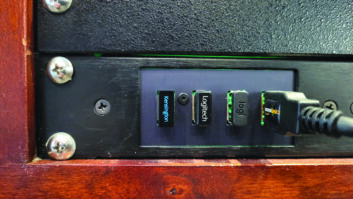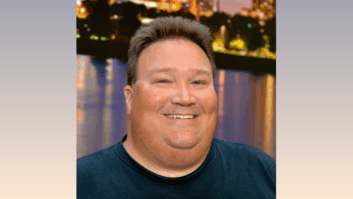DIY: How to Make Bass Traps
Feb 1, 2012 1:10 AM, by Chris Wygal, CBRE

When pesky resonant modes make an otherwise good recording facility sound hollow and tankish, hanging foam or carpet on the walls will usually fail to fix the problem. Without belaboring physics, resonant modes and standing waves are simply sound frequencies that, due to the physical dimensions of a space, seemingly get stuck in parts of the room. Standing waves can vary, but are usually midrange in nature, and can ruin the sound of a recording. A room that has four 90-degree corners and is nearly or perfectly square is destined to suffer from standing waves and resonant modes. The best way to destroy them is to put something in the room corners to break up their shenanigans.
I recently built a studio for personal use with a recording space measuring 11’x7′. The room is by no means square, but for some reason I found an obvious resonance at approximately 300Hz. So I decided to build my own bass traps. Also known as corner traps, these objects come in all sorts of sizes and styles, and are designed to fit nicely in 90-degree corners.

The completed trap shown before installation
The sizing of my bass traps was anything but scientific. It was solely based on the 2’x2′ foam absorbing panels I had left over from another studio. They basically decided for me that the bass traps would be 48″ high and have a front surface 24″ in length. With that decision, I took a leap of faith and purchased enough pine 1x4s, 1/2″ plywood, R-13 insulation and tempered hardboard to start experimenting. For creativity’s sake, I wanted a curved front surface. I did some math (pd = C (d=diameter, C=circumference), knowing a full circle would be 4×24=96) to make sure the curved front yielded a 24″ surface area across. The structure of the bass traps would consist of three (top, middle and bottom) 1/2″ plywood layers equally spaced 24″ apart, held together by 1×4″ pine beams. The 1/2″ plywood parts had 15″ sides, which allowed for the face to be the necessary 24″. The 1×4″ pine beams were cut 48″, and the plywood parts were notched appropriately in three places so the plywood levels could be nailed to them. Once the skeleton was in place, I cut a 24″x48″ piece of tempered hardboard (similar to pegboard material, but without the holes). Tempered hardboard is light and flexible, but also stubborn. It was barely cooperative enough to roll around the curved front of the bass trap without busting apart on the edges. This step required drywall screws. The hardboard would have pulled nails or staples out.
Once the wood structure was assembled, I used double-sided tape to hold the two 24″x24″ foam pieces on the curved front. In hindsight, one piece of foam would have looked better, but the foam I had cost $0.00. With the foam in place, I stuffed the inside of the trap with R-13 fiberglass insulation. Why R-13? Because I happened to have that lying around too. Nonetheless, the insulation prevents standing waves inside the trap from resonating. Without it, the trap would serve no purpose, other than maybe as a diffuser, which I didn’t need.
After the prototype trap was completed, I built three more just like it. Aesthetically speaking, the traps may be a little too big for the room, but from an acoustics perspective they work extraordinarily well. The room has no standing waves and you can’t “hear” the recording space on tape. The walls are carpeted with grey marine carpet, which keeps reflections to a minimum. With the homemade bass traps, I’ve achieved a spectacular acoustic environment for a fraction of what I could have spent.

One of the traps installed in the corner.
Wygal is the programmer and engineer for Victory FM at Liberty University, Lynchburg, VA.
February 2012
WAOK uses Method of Moments modeling, IBOC update, the Tieline Bridge-IT is taken on the road, and new EAS rules are released….







